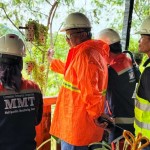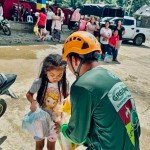For higher commercial value; environmental efficiency
src=”http://tvird.com.ph/wp-content/uploads/content-img/070829a.jpg”>
Fernandez Anda with family members at his newly planted rice farm.
After 51 years of moving from one place to another, subsisting
on traditional slash-and-burn farming in the remote mountains of the Zamboanga
Peninsula, Fernandez Anda has finally found a home – one where he can grow high
quality crops in commercial quantities to support his family.
As a pilot beneficiary of TVI Resource Development Philippines, Inc.’s (TVIRD)
Farmer-Instructor Technician Program (FIT), Anda has converted some 8,000 square
meters of his ancestral domain claim in Canatuan into a model farm, using the
technology he just recently learned under FIT’s Rice Terraces Project. Eventually,
with technical support from TVIRD, Anda’s farm will be extended to cover
much of the land he owns.
“Sukad sa una, kanunay lang kami nagbalhin-balhin gikan sa usa ka lugar
ngadto sa lain aron lamang mag-uma pinaagi sa kaingin. Lisod kaayo kanamo nga
magpundo sa usa ka lugar tungod kay human kami maka-ani maka-usa lamang sa usa
ka tuig, mangita na usab kami ug laing lugar aron ipahigayon ang pagkaingin.
(We always moved from one place to another to be able to farm using the slash-and-burn
method. It was difficult for us to settle in just one place because after harvesting
one area once a year, we had to look for another area to farm),” Anda related.
Undertaken through TVIRD’s Social Development and Management Plan (SDMP),
the FIT Rice Terraces Project provided for an irrigation system that involved
the diversion of a natural water source to Anda’s rice paddies. Plans are
also being considered to apply multi-cropping techniques to his farm – to maximize
the use of the irrigation system and enhance income opportunities for Anda and
other farmers like him in the area.
src=”http://tvird.com.ph/wp-content/uploads/content-img/070829b.jpg”>
Water flows from a natural source to the rice terraces.
“Through these techniques, Subanons like Anda will not only harvest once a
year, but three or even four times, since he now has an unlimited supply of water
for his crops,” said TVIRD Canatuan General Manager Magellan Bagayao after
sharing a meal with the Subanons and helping out in the planting of the rice crops
during the project launch. “We hope he will be able to share this new approach
with his fellow Subanons, and the slash-and-burn method of farming will eventually
be eradicated. This project not only helps provide the Subanons a sustainable
means of livelihood. It is also pro-environment,” added Bagayao, an Igorot
indigenous person himself who hails from a region in northern Philippines that
is world famous for its Banaue Rice Terreces.
During the launch, the IPs were also taught techniques that would help increase the yield of camote (sweet potato), a popular root crop.
Armed with new concepts that are environmentally friendly, and with a source of
income deriving from several harvests annually, Anda said: “Dili na kinahanglan
pa nga magbalhin-balhin kami aron lamang adunay panginabuhian ug makaon. Usa pa
niini, malikayan usab namo nga makadaut sa kinaiyahan pinaagi sa kaingin.
(We no longer have to transfer from one place to another just to have something
to eat. And, we can now also avoid the destruction of the environment, which was
the case when we employed the old slash-and-burn farming methods.”
The Rice Terraces Project is one of the programs undertaken by TVIRD through CReDO in the livelihood-agroforestry component of its SDMP. To date, the Company has invested a total of over P5.4 million to fund its SDMP projects.
TVIRD operates a gold-silver mine in Canatuan, located in Siocon town in Zamboanga
del Norte. The Company’s expansion into copper-zinc production is set to
become operational in mid-2008. (Rene Patangan)
src=”http://tvird.com.ph/wp-content/uploads/content-img/070829c.jpg”>
GM Magi Bagayao (in blue shirt and white hard hat) and TVIRD staff take part in the planting



